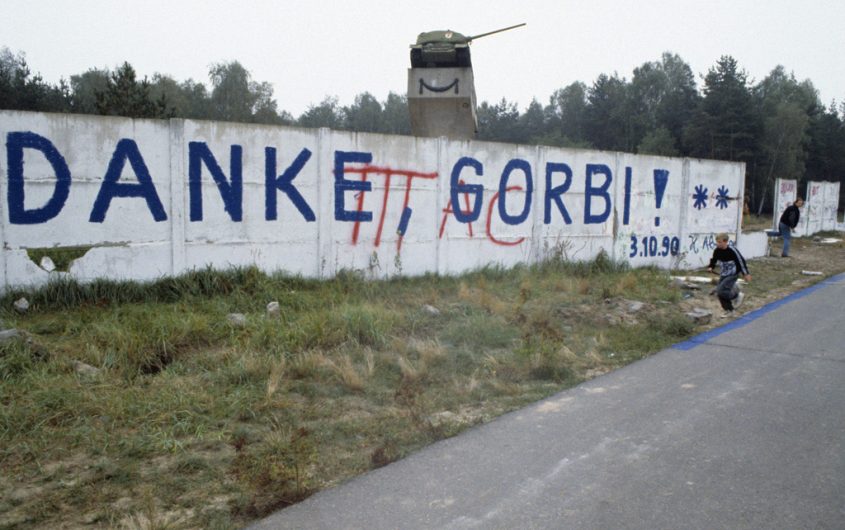
Looking Back at German Reunification Thirty Years Later

Eric Langenbacher
Senior Fellow; Director, Society, Culture & Politics Program
Dr. Eric Langenbacher is a Senior Fellow and Director of the Society, Culture & Politics Program at AICGS.
Dr. Langenbacher studied in Canada before completing his PhD in Georgetown University’s Government Department in 2002. His research interests include collective memory, political culture, and electoral politics in Germany and Europe. Recent publications include the edited volumes Twilight of the Merkel Era: Power and Politics in Germany after the 2017 Bundestag Election (2019), The Merkel Republic: The 2013 Bundestag Election and its Consequences (2015), Dynamics of Memory and Identity in Contemporary Europe (co-edited with Ruth Wittlinger and Bill Niven, 2013), Power and the Past: Collective Memory and International Relations (co-edited with Yossi Shain, 2010), and From the Bonn to the Berlin Republic: Germany at the Twentieth Anniversary of Unification (co-edited with Jeffrey J. Anderson, 2010). With David Conradt, he is also the author of The German Polity, 10th and 11th edition (2013, 2017).
Dr. Langenbacher remains affiliated with Georgetown University as Teaching Professor and Director of the Honors Program in the Department of Government. He has also taught at George Washington University, Washington College, The University of Navarre, and the Universidad Nacional de General San Martin in Buenos Aires, Argentina, and has given talks across the world. He was selected Faculty Member of the Year by the School of Foreign Service in 2009 and was awarded a Fulbright grant in 1999-2000 and the Hopper Memorial Fellowship at Georgetown in 2000-2001. Since 2005, he has also been Managing Editor of German Politics and Society, which is housed in Georgetown’s BMW Center for German and European Studies. Dr. Langenbacher has also planned and run dozens of short programs for groups from abroad, as well as for the U.S. Departments of State and Defense on a variety of topics pertaining to American and comparative politics, business, culture, and public policy.
__
Germans have long contrasted the fall of the Berlin Wall in November 1989 with the much more sober formal reunification of East and West Germany in October 1990. The fall of the wall was the spontaneous, authentic, and joyous moment no one expected. It was also the product of months of grassroots mobilization by average East German citizens. Some commentators opined that this was the first successful (and peaceful) German revolution and it certainly was a domestic achievement however much inspiration Easterners had from people in Poland, Hungary, and elsewhere. The mood in the weeks after this event was exhilarating—especially as the Iron Curtain continued to fall rapidly in places like Czechoslovakia, Romania, and Bulgaria.
Reunification, on the other hand, was likened to a hangover. It was also quintessentially top-down and bureaucratic—with constant discussion between the Western government led by Helmut Kohl and the new democratically elected (on March 18, 1990) Eastern government headed by Lothar de Maizière. There were also extensive negotiations among the two Germanies and their international partners (and former conquerors) in the so-called 2+4 negotiations. The resulting Treaty on the Final Settlement with Respect to Germany signed on September 12 included the four Allied powers renouncing all rights, the Soviet Union withdrawing its forces by 1994, limiting the size of the German armed forces, recognizing all of Germany’s existing borders, and prohibiting any additional territories from ever joining the country. Moreover, the socio-economic circumstances were daunting with the realization of just how dilapidated Eastern infrastructure was and how rapidly the East German economy was collapsing. Westerners were worried about the massive costs that rebuilding the East would entail.
Why October 3rd?
There is a bit of misunderstanding around the selection of Wednesday, October 3, 1990 as the first Day of German Unity (Tag der Einheit). Many think erroneously that Chancellor Kohl arbitrarily chose the date because the much more resonant November 9th when the Berlin Wall fell was too fraught, as it also marked the infamous Kristallnacht pogrom of 1938 and the declaration of a republic in 1918. Others opined that October lacked a holiday. As an interesting aside, the Tag der Einheit is the only federally mandated holiday in Germany. All other holidays are determined by the individual states. Also, implementing the new holiday did away with the previous West German national holiday on the 17th of June, commemorating the 1953 uprising in East Berlin, as well as East Germany’s celebration of Republic Day on October 7th.
Instead, it was the East German parliament, the Volkskammer, that decided toward the end of August that the newly reconstructed states in the East would legally join the Federal Republic through Article 23 of the Basic Law (used only once before in 1957 when the Saarland joined the FRG and abolished after formal reunification). These states—subsequently, if awkwardly known as the five “new” federal states (die neue Bundesländer) of Mecklenburg-West Pomerania, Brandenburg, Saxony-Anhalt, Thuringia, and Saxony—became legal entities on the date of formal reunification. In the prewar era, the states on the territory of the eventual GDR were more complex and the state of Prussia (abolished in 1947) had numerous provinces here. The communist authorities abolished the states in 1952, replacing them with fourteen districts (Bezirke). The “new” states post 1990 were for the most part formed from the Bezirke. Of course, the post-1990 states were not so “new” after all—in many cases re-constituting some of the most historical political entities in Germany. The Finnish name for Germany is Saksa and, of course, “Anglo-Saxon” is well-known in the English-speaking world. Brandenburg (specifically Brandenburg-Schwedt) even had some Bach concertos named after it in the eighteenth century!
“Was bleibt?” Thirty Years Later
As we now mark the thirtieth anniversary of formal reunification, what are the lingering takeaways? First, although the process and achievements today seem overdetermined, I think we all need to try to remember how much uncertainty and contingency shadowed the process over the 300+ days from November 1989 to October 1990. Actually, everything was essentially in place months earlier in May when monetary, economic, and social unification was agreed upon, coming into force on July 1, 1990, when the Deutsche Mark became the legal tender across both regions. Many experts believe that one of the most consequential decisions was Kohl’s decision to do a 1:1 exchange (up to 4,000 Eastern marks, then 2:1) between Eastern to Western marks. This decimated Eastern industry and arguably led to the complete collapse of most enterprises there—exacerbated by the decision to privatize all (8,000 or so) state-owned assets as quickly as possible through the so-called Treuhandanstalt holding company. There is a veritable library full of diatribes against the work of the agency. The AfD and Linke are even trying to get an official governmental investigation (Untersuchungsausschuss) of the Treuhand’s work.
However legitimate some of these criticisms are, I have always had sympathy for Kohl, his government, and the West German bureaucracy. Kohl was a politician trying to get votes after all, and thought that such a generous exchange rate would provide short-term relief for Easterners. Hindsight is 20/20 and he likely was not fully aware of the larger dire structural consequences of this decision. I recall at the time, people thought this decision would have a more negative impact on the West. We should also remember the unprecedented outflow of Easterners moving west for opportunity—approximately 1 million people between 1989 and 1992. Kohl and many others felt that they had to stabilize the situation before it was too late—even at a high cost. Kohl also needed to be cognizant of how his voters in the West were reacting to the flood of newcomers.
Another related criticism was constitutional. The Basic Law was never called a constitution and was intended to be provisional until a full unification could occur. In fact, the Basic Law even had a provision (Article 146) that a real, bonafide constitution could be promulgated when the country reunified. But, Kohl and others decided to stick with the well-tested and greatly respected Basic Law. Many leftists and easterners still lament this “lost opportunity” to this day. Once again, Kohl did not think the time involved for such an endeavor was something Germans had over the course of 1990—and that a “rush job” would have been undesirable.
Yet, we also need to recall the greater geopolitical environment. The positions of all of the main powers were variable and at times contradictory—except perhaps for the George HW Bush administration, which was stalwart in its support for Kohl and the unification process. But, the British under Margaret Thatcher and the French with François Mitterrand were different stories,needing to be reassured constantly that reunified Germany would not be a threat or that more general upheaval in central and eastern Europe could be managed. This is one reason Kohl promised European Monetary Union in exchange for French support for reunification.
Even more worrisome was the Soviet Union. No one predicted the rapid fall of the eastern European satellites and increasing instability within that country. Everyone feared a potential backlash to Mikhail Gorbachev and his reformist agenda with hardliners trying to reassert control. This situation lent a sense of urgency to questions about German reunification. And indeed, many of these fears were justified as communist hardliners attempted a coup in August 1991. Although this failed, the USSR was dissolved into its constituent republics in December 1991. Mention should also be made of the U.S.—suddenly the leader of a unipolar world—and the distractions that came with that. Indeed, the first Gulf War broke out in early August 1990, indicating a shift in attention from this all-important power.
Looking back, it is clear to me that the reunification process was handled about as well as anyone could have expected. Given the uncertain international environment, the collapsing Eastern economy, and tens of thousands moving West every month, decision-makers did not have the luxury of time to have done things that much differently. Moreover, many of the critics had little of substance to offer in lieu of what actually happened.







